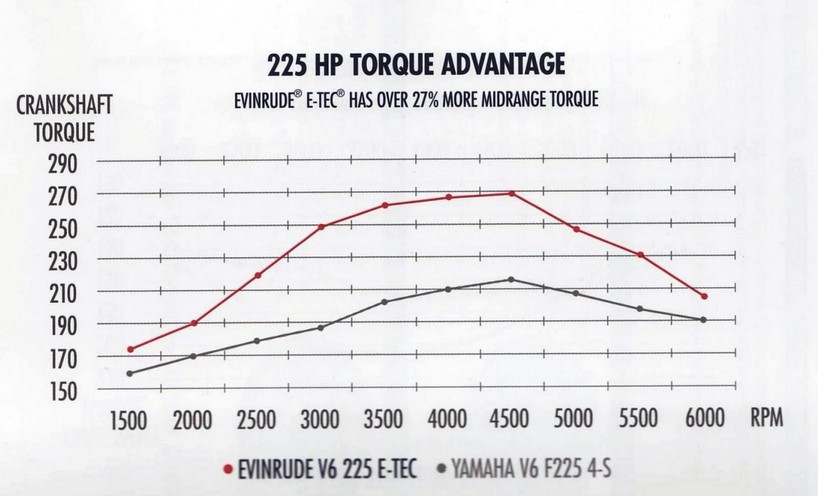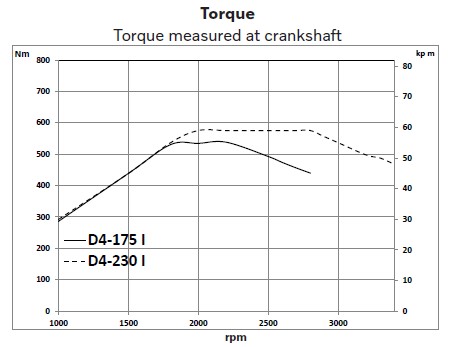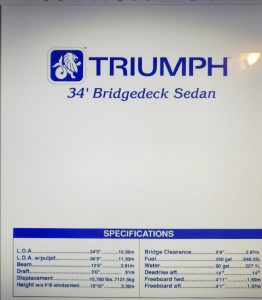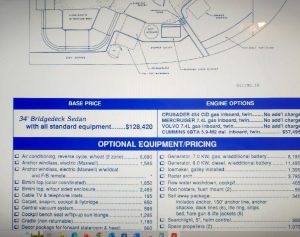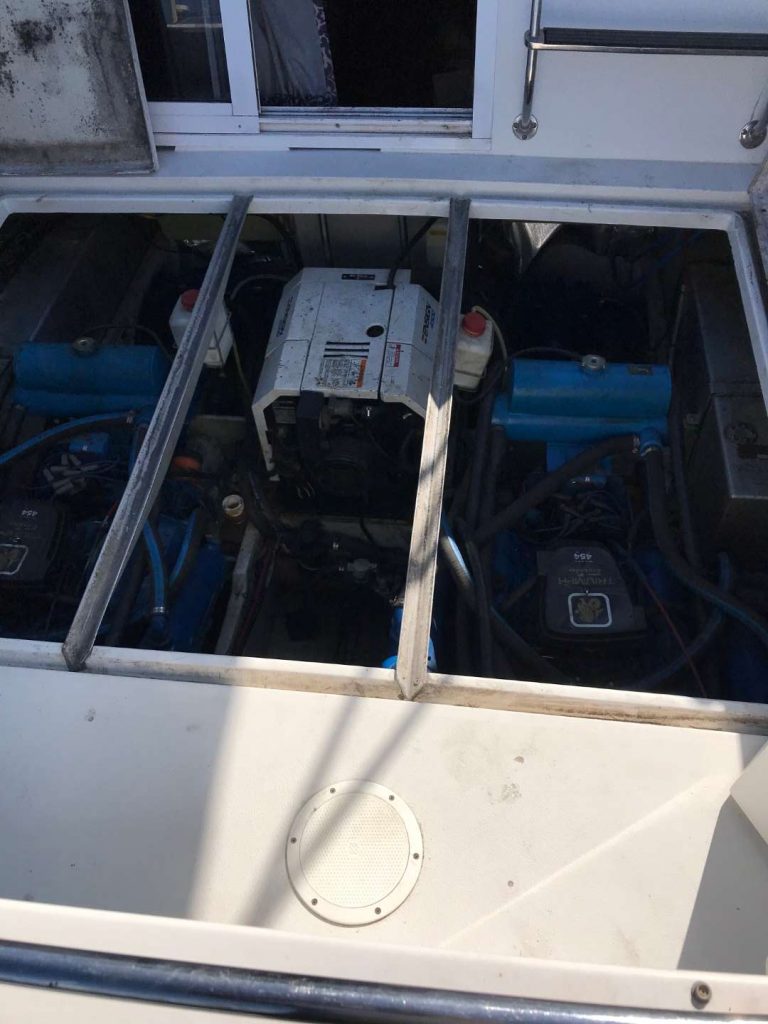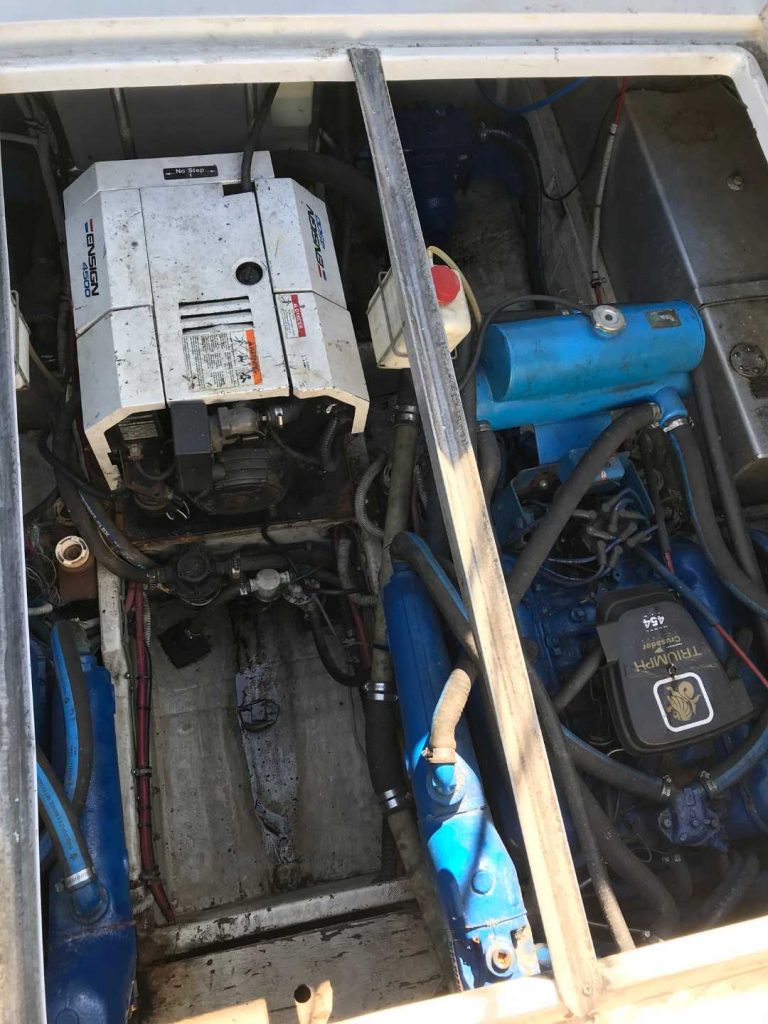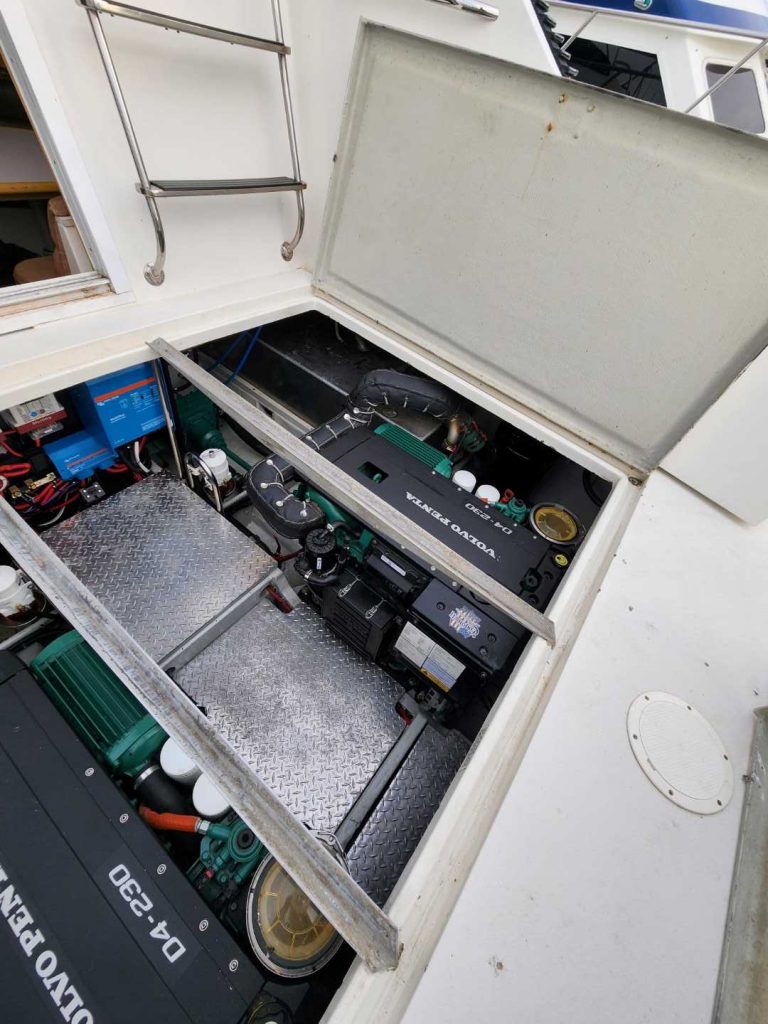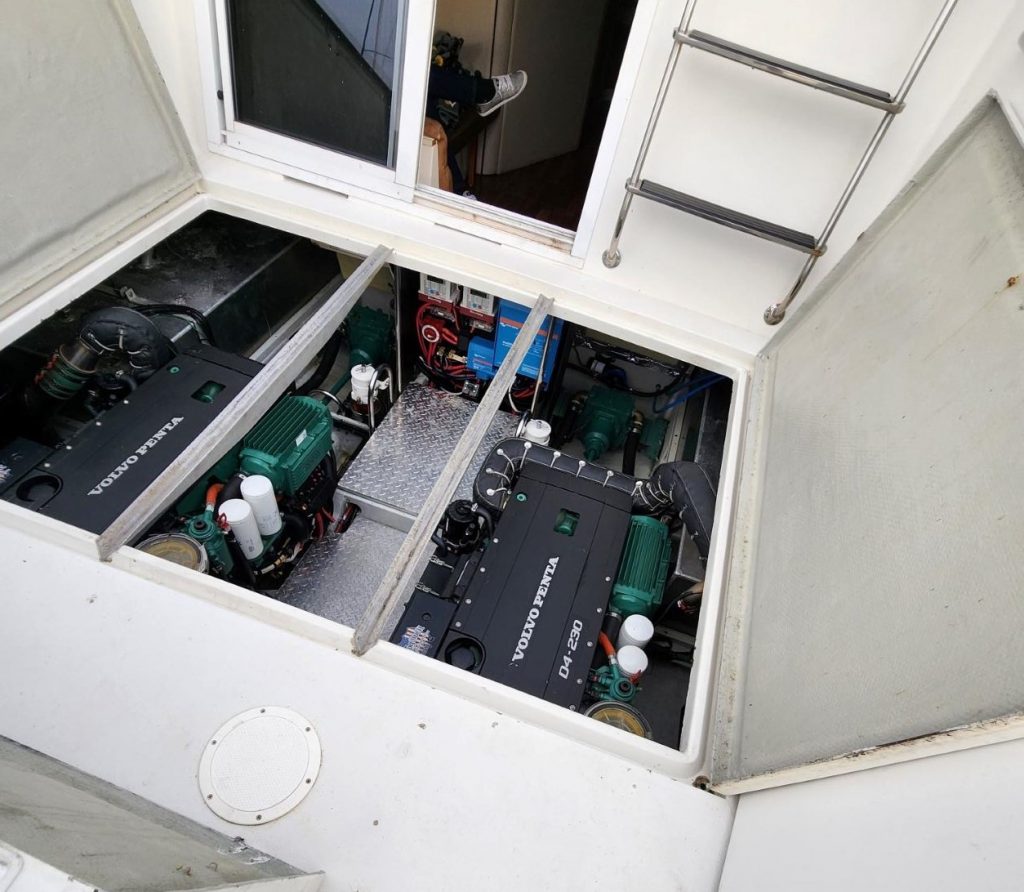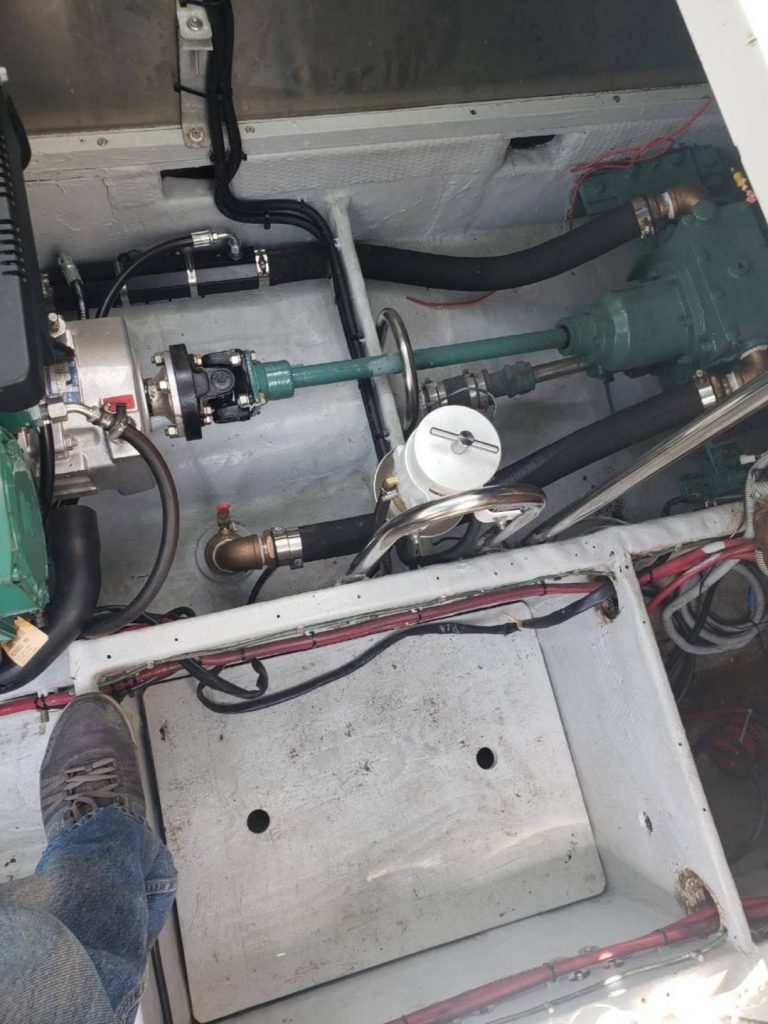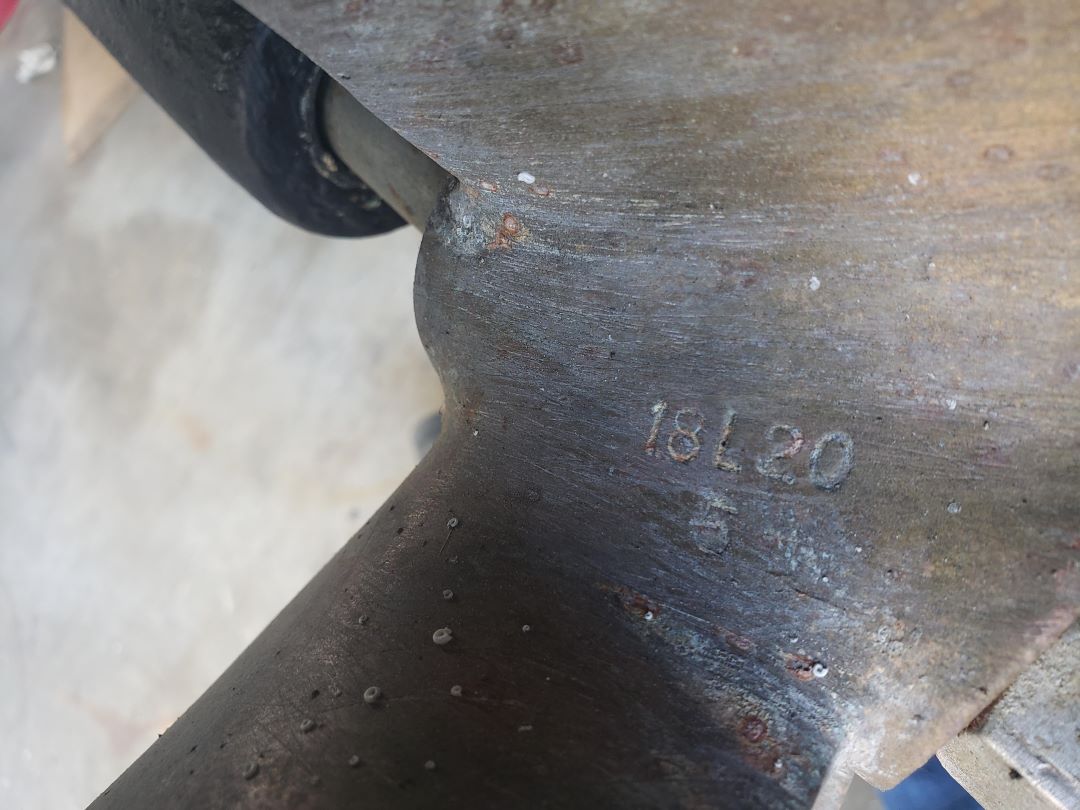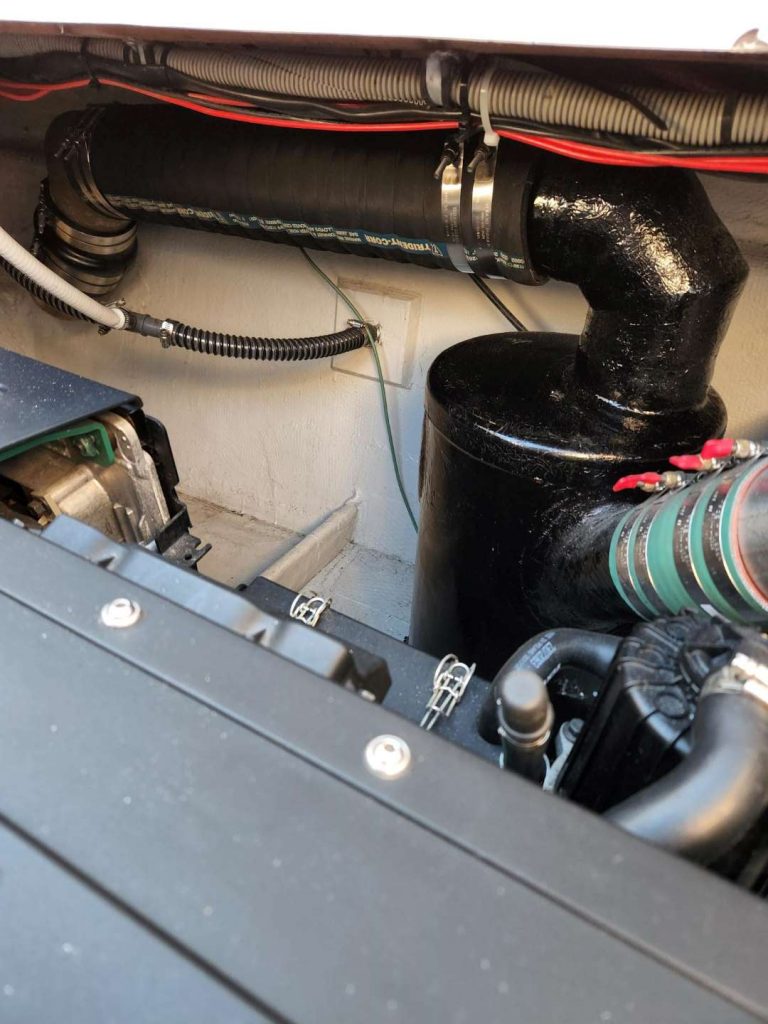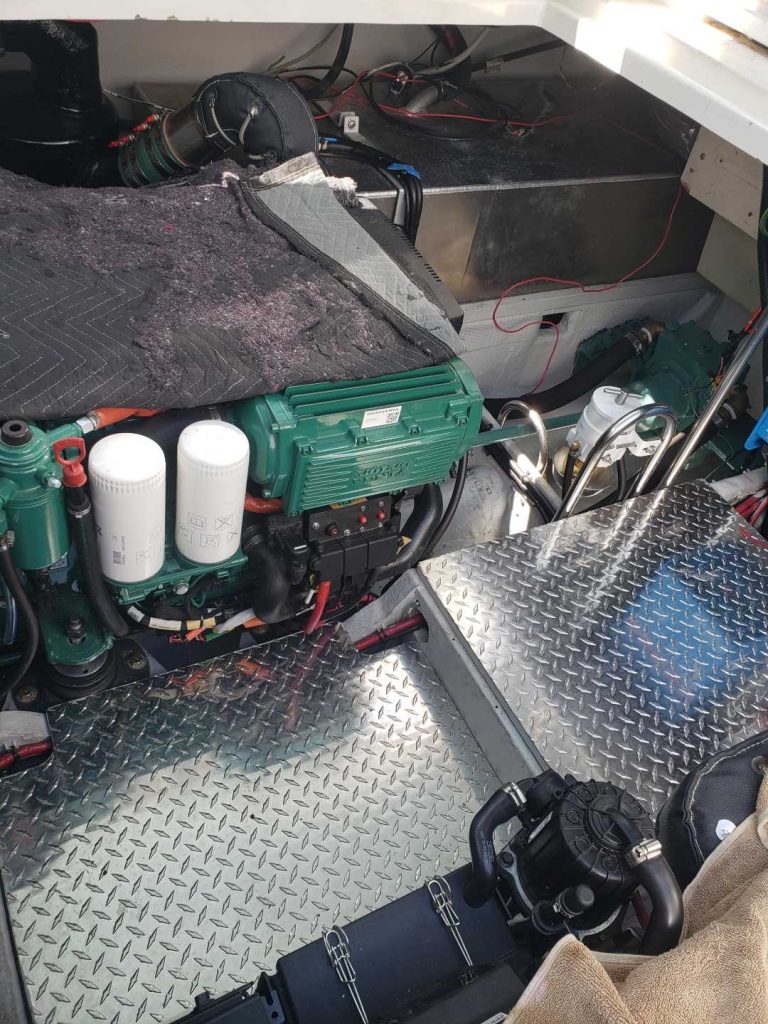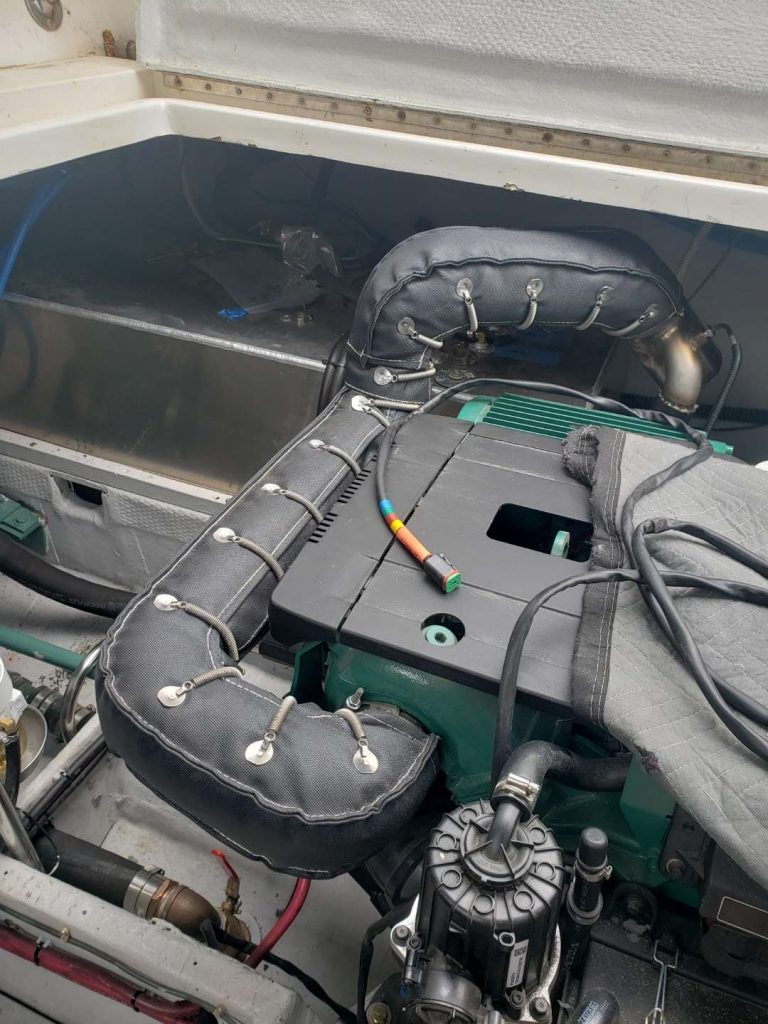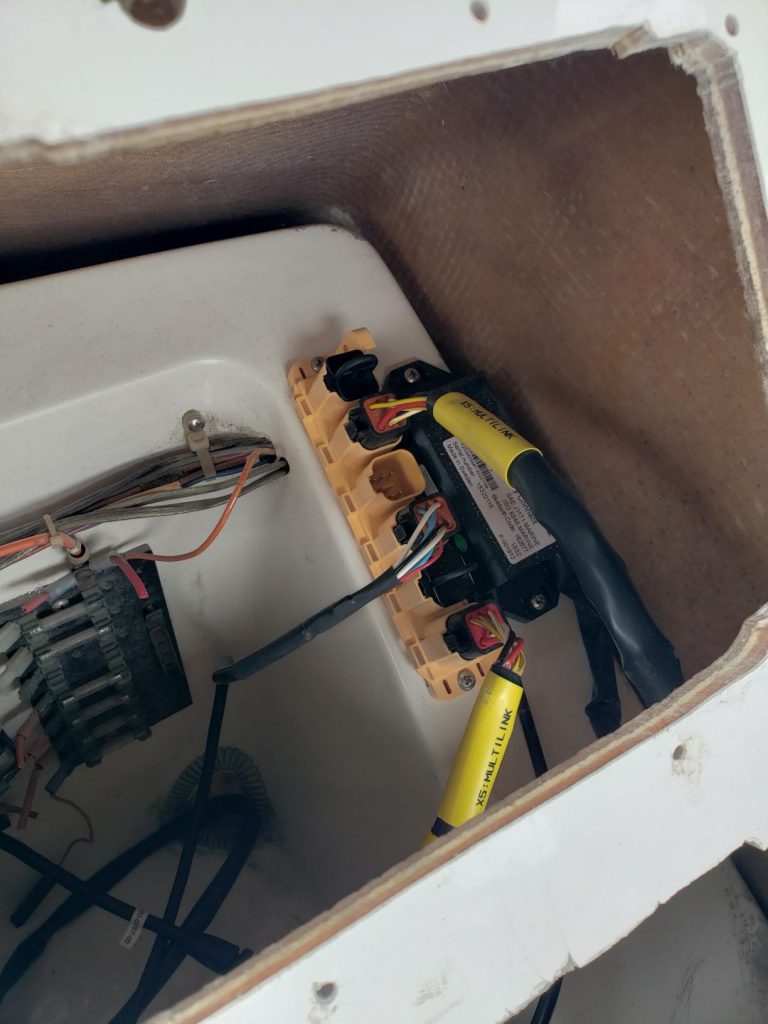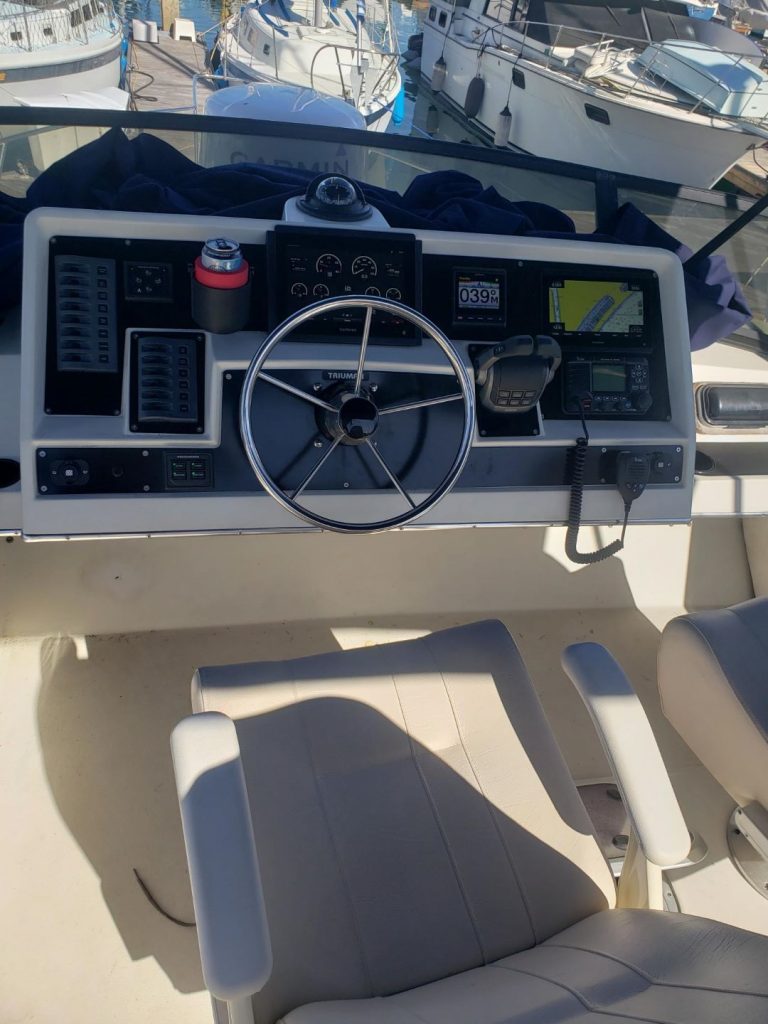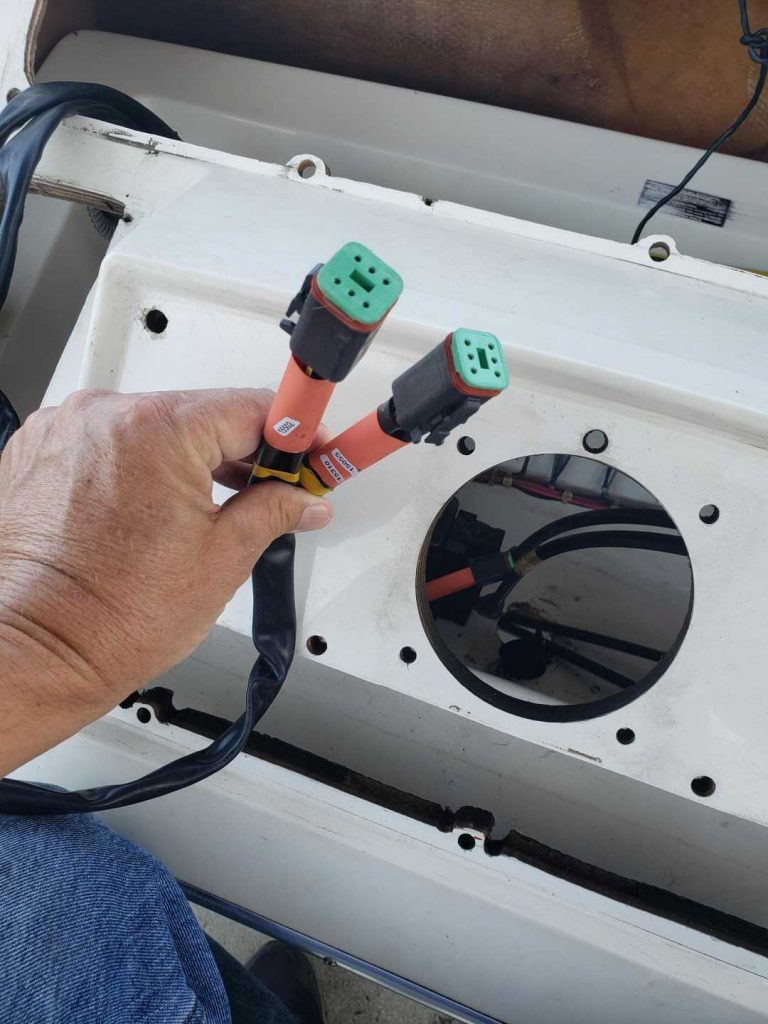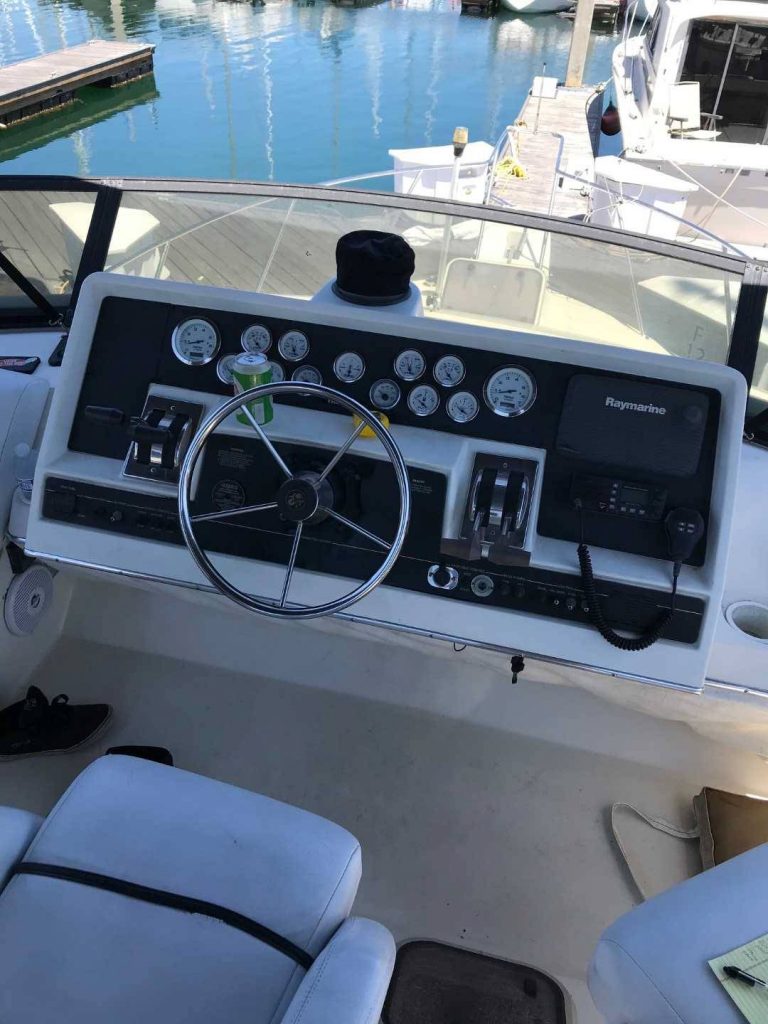Part I: The Guide
Step 1
Torque: This guide uses a backwards approach to determine the engine sizing based on how much torque the existing v-drives and prop shafts can handle. Instead of defining an engine by horsepower as most people do, the guide will define an engine by torque. For this backwards approach, we would say a diesel engine has the same torque as a gas engine but it has less horsepower. Although the torque will be about the same on both engines, the torque will be available at lower RPMs on a diesel engine compared to a gas engine.
The value of a diesel engine comes from being able to produce high torque at lower RPMs. Torque is needed when getting a heavy boat up on a plane, pushing through heavy seas or dealing with a headwind. The planing boat diesel engine can apply high torque at RPM’s closer to 2000 RPM. The gas engine will need higher RPMs to get the same amount of torque. Therefore, the diesel will be more efficient while moving a heavy boat because the torque is available at lower RPMs where the fuel burn is less.
Locate a spec sheet for the gas engines you have and find the maximum torque, then search for a diesel that has that same maximum torque. The torque will not be listed as a line item on the engine specs. There will usually be a graph next to the list of engine specs. Match the maximum gas engine torque (usually at a higher RPM) to a diesel planing boat engine that has that same maximum torque (probably closer to 2000 RPM). You just found the model number of an engine that is correctly sized to your boat. This does not mean your drivetrain will work yet. The torque that the drivetrain can handle is RPM dependent, but at least you are close enough to start asking questions.
Step 2
Weight: The engines on any boat are also ballast. Aft engine ballast needs special consideration. If the engines are too heavy, then the boat may not be seaworthy as it squats at the aft end. If they are too light, then the boat “pad” may become over buoyant, which makes the bow under buoyant. An under buoyant bow can stuff into a wave and submerge the boat. The replacement engines should be close to the weight of the engines that came out of the boat. The generator and house bank batteries are also ballast. They can be moved or reconfigured. Fuel tank relocation is usually too much work.
Now is the time to get your hands on the original boat brochure that was used to advertise the boat when it was new. An internet search of old boat brochures should help. The brochure should give details if the boat came with different engine options. Just because the boat had a diesel option when it was new does not mean the boat was designed to have those heavy engines. I have seen diesel optioned boats from the factory squatting horribly on the aft end. The brochure should give more information to make decisions on weight, but your common sense overrides the sales brochure.
Step 3
Horsepower: We don’t have to make a blind call to the dealer for selecting a horsepower model if we can do a little pre-investigation first. The horsepower calculations can be cheated as a preliminary step to guess the correct engine before calling the dealer.
We matched the known torque of the existing gas engine to the torque of a diesel engine in step 1. The horsepower was given to us by looking at the model number and spec sheet of that engine. This step should be repeated for all diesel engine manufacturers who have an engine that meets your torque, weight and RPM requirements. Now, evaluate all of the engine candidates by using steps 1- 6 to let the boat choose the best engine for itself. You will be providing some guidance on the boat’s decision.
Call the dealer after completing steps 1-6. The dealer will want the boat hull specifications and also prop shaft length, prop shaft diameter and v-drive reduction so they can run the calculations that we just skipped. The engine dealer will most likely talk to their engine manufacturer’s representative to have them help with the math. They will look at the v-drive reduction and see if they can find a transmission gear ratio and prop pitch to make the whole package work. This is where the dealer will inform you of the new required prop size.
The dealer calculations will determine exactly what horsepower the boat will get for the product they are selling. You already have a good idea of what their horsepower selection will be from completing step 1. If the maximum torque of the newly selected diesel engine is more than the maximum torque of the gas engine, then a new drive train will most likely be required. Either way, calculations must be run for the jack shaft, v-drive, and prop shaft. The dealer must have the serial numbers from both v-drives before calling the v-drive manufacturer to ask if the drives are rated to handle the torque curve of the newly selected diesel engine.
If the dealer moves the boat to the highest horsepower for an engine block series, then consider the engine block may be working too hard. If you are at the highest horsepower on an engine block to meet minimum boat performance, then you may want to ask the manufacturer representative who ran the calculations to give something in writing stating their engine block and horsepower selection will not cause warrantee issues with your specific boat. Make sure the warrantee is transferrable and keep that paper with your insurance documents. Ask about the expected service life of that marginally sized engine too.
Step 4
RPMs: The skipper needs to be able to move the boat in and out of the slip, marina, and through no-wake zones at a slow speed. Let’s assume the engines idle at 700 RPM (Revolution Per Minute). That means when the boat is in gear and running at 700 RPM, the boat needs to be moving slow enough to navigate through these areas. The range between 700 RPM and the max RPM of the engine will be one of the determining factors on the overall speed of the boat.
Let’s assume the maximum RPM on a gas engine is 4700 RPMs. That means there is a 4000 RPM difference between idle and max engine RPM. That should be fast boat. Let’s assume a low RPM diesel has a max RPM of 1700 RPMs. That means there is only a 1000 RPM difference between idle and max RPM. That is a much slower boat. It makes sense that a higher RPM engine can get a planing boat to plane faster because it is spinning the prop faster.
Many people say bad things about high RPM diesel engines because problems develop more quickly while running at 3000 RPMs as opposed to running at 1500 RPMs. However, the new diesel engines have a computer that will probably alarm early on and possibly reduce the performance of the engine to lower the risk of a catastrophic failure. Also, don’t listen to a person repeating bad stories about a high RPM diesel engine unless you first know for sure that the planing engine in question was not undersized for the boat it was pushing.
Step 5
Engine Displacement and longevity: Engine displacement is basically the measurement of cylinder volume inside the engine. Engine displacement can indicate how long of a service life to expect from the engine. A higher displacement engine for a given horsepower usually means the engine does not have to work as hard to achieve the rated horsepower, so it should have a longer life. There are four concepts that need to be considered for a long engine life.
First, what is the realistic service life of a recreational boat engine? I am making assumptions because we need some place to start. Let’s assume the average recreational boater puts about 100 hours a year on their engines. Let’s assume people in the marina expect a planing boat diesel engine to last about 30 years before it is obsolete. By this logic we would want to match a recreational planing boat with an engine that should have a service life of 3,000 hours. I will use 30 years and 3,000 hours throughout the rest of this guide because it makes sense to me. You can adjust this number if you don’t like it.
Second, do high RPMs make a shorter engine life? This is where the engine buyer needs to look at the bigger picture of boat performance vs engine longevity. Some people get so caught up in the idea of engine longevity that they forget the engine also has a job of making a planing boat go fast. Yes, a higher RPM engine will be under more stress than a lower RPM engine and that will lead to a shorter life. However, the difference in lost longevity should not be noticed by a recreational boater who is only trying to get 3,000 hours from an engine. A commercial operator who is trying to get 10,000 hours from an engine may favor a lower RPM engine, but he will go slower too.
Third, is the engine design overstressed from having a small displacement? An engine block has the same displacement for all horsepower options on that block. Practically speaking, the lowest horsepower option for that engine block series will have an easy life. The highest horsepower option on that same block will have a hard life because it will have to make a lot more power without having any more displacement. That stress will shorten the life of the engine. As long as the additional stress does not shorten the expected service life to under 3,000 hours for a recreational boat, then there should not be an issue, unless…
Fourth, is the engine block too small for the boat? If the biggest horsepower rating on that block just meets the minimum power needed to get the planing boat to perform, then the engine is probably too small for the boat and it will probably have a short life. That undersized engine should get the job done for a while, but now there is a double engine stress problem. An already stressed, max horsepower on a block engine is now being put into a heavy boat that will stress the engine to the maximum all the time just to keep the heavy planing boat up on a plane.
Keep in mind, any boat will probably always be heavier that what the designer intended. It is extremely hard to control the boat weight during the manufacturing process. Just ask the people who build racing boats of any type and then put them on a scale afterwards. Therefore, the planing boat engine should be sized to meet a margin of error of extra boat hull weight than what is advertised in the boat brochure. The engine and drive train will become even more stressed when the boat is loaded heavy with fuel, water, extra people and gear for a big trip. Good luck trying to get 3,000 hours of service life from a marginally sized engine block that just barley meets specs.
Should a recreational boat owner be insisting on the highest displacement engine they can get? Having a high displacement commercial engine block is not an excuse to undersize the engines. If the high displacement commercial engine is on the max horsepower for its block, and the engine is undersized for that planing boat, then the same principals of longevity should still apply. However, a correctly applied high displacement commercial engine that is put in a recreational boat will probably have some hours left on the meter at the time the engine becomes obsolete in 30 years. It’s not a bad thing or a good thing. It is what it is.
Step 6
Review engine choice: An engine model number will be chosen first by the torque it produces. The engine should be a higher RPM engine for planing. That model number should then be evaluated for its placement on the engine block series and your expectations of longevity. The weight should be close to the weight of the engine being pulled out. Calculations must be run by the dealer who is installing the engines. Having one shop do calculations and another shop ordering and installing the engines is not a good plan.
The lowest horsepower engine on an engine block series may not produce enough power to justify its heavy weight for a planing boat. It will likely be rated to run at lower RPMs too. It is probably best to leave that engine for a non-planing boat and have your planing boat engine horsepower model be somewhere in the middle of a block series.
If the boat chooses an engine that does not work for you, then don’t make a compromise. Scrap the repower. The repower project is too costly and emotionally draining for you to end up with something that is just okay. If something does not feel right, stop now.
Engine weight is a big issue on the smaller boats that are closer to 10,000 pounds. There may only be one good diesel engine choice for the boat. When the boat is in the range of 20,000 pounds, then it can start carrying 6-cylinder engines and a lot more engine choices become available. The bigger boat is also more forgiving on adding or subtracting a few pounds of engine weight, so the boat owner will have plenty of options on repowering. See part 2, section 1 for understanding the weight of a boat and engine options.
Step 7
Prop shaft, jack shaft and v-drive: There are two types of v-drives. One type is directly bolted to the engine’s transmission and it angles the prop shaft out directly under the engine. It does not have a jack shaft. The second type is stand alone and is bolted to the boat stringers and it is mounted a couple feet forward of the engine. There is a jack shaft (short drive shaft) that connects the engine’s transmission to the stand-alone v-drive.
I’ve been told that v-drives are very durable and it is not recommended to proactively replace them. Replacing any part of the drivetrain will add more variables to the scope of the repowering project. There are no fixed costs on the project, so adding more variables will increase your regret potential for doing this project. The need for replacing the prop shafts and v-drives ends up being the tipping point for most people (including myself) on whether or not they will repower the boat. I would still insist that the v-drives are removed and seals replaced.
I needed a cell phone camera or a mirror to find the rating plate on my v-drives. A scotch-brite scrubbing pad to clean the rating plates was necessary. I found both v-drives did not have the same model numbers because they rotated in opposite directions so be sure to check both rating plates. Take a picture of both rating plates so you have the reduction gear ratios with model and serial numbers for future reference. Try to see if there is a gear reduction rating plate on the transmissions and get a picture of that too.
My stand-alone v-drives were 30 years old and presented an issue after the repower. The boat was not getting much use with the previous owner so a small leak from the v-drive seals did not get noticed earlier. The leaks became obvious after I had a clean engine compartment and the boat was getting a lot of use. That was about the same time the brand-new starboard transmission blew up. The wrong transmission was selected by Volvo in the planning stages (covered in the next section). A counterrotating v-drive had to be ordered after the repower project was complete. Plankton also needed to go up one size for the v-drive. Now I know why nobody wants to repower a boat.
There was an additional issue. Calculations were not run on the v-drive or prop and jack shafts because the old Crusaders produced just a little bit more torque than the new Volvos so the v-drives must be fine when going to the diesel Volvos, right? Wrong! The old Crusader gas engines produced their max torque at a high RPM, and that puts less torque on the shaft when the prop is spinning faster. The torque rating of the drive train is RPM dependent. That should have been obvious because the diesel will turn bigger props. Now I know why engine torque is given on a chart, and not as a straight number on the engine specification sheet. Beware: make sure to run calculations on the entire drive train!
The 1 ¼ inch jack shafts (between the engines and v-drive) needed to be upsized to 1 ½ inch after the project was complete. The existing prop shafts (between the v-drives and props) were still within safety margin calculations for a recreational use boat. That is because there is a power loss as the driveline goes through the v-drive. I think it is about a 7% power efficiency loss. If the boat is to go into commercial use, then it may need to have a different safety margin factor and the boat might need to move up to 1 ½ inch prop shafts.
Note: The engine is mounted backwards in the boat when a v-drive is used. The shop will continue to call the front of the engine (where the belts are) the front of the engine, even though it is facing the back of the boat. Just keep that in mind.
Step 8
Transmission: A V-drive is a transmission, but I will not call it a transmission here so we can avoid confusion between components. Let’s just say there is an engine, transmission, v-drive and a prop.
Volvo ran calculations for Plankton and decided on a ZF transmission and what prop size would be needed. I really did not do any planning or make any decisions. The following two sections are what I think I learned along the way.
Volvo does not offer a counter rotating engine shaft on the D4 block. I was concerned about compatibility with my existing v-drives because the old port and starboard Crusader engines rotated in opposite directions. That ended up not being an issue because the new transmissions have planetary gears. The same transmission can be configured to rotate the shaft in either direction at the time it is installed.
Well, that was the theory anyhow until I blew up one of the transmissions while rounding Point Loma with a heavy loaded boat for a one-week trip to Catalina, and I was pushing it hard. I later found out that these specific planetary transmissions need to be running in the A position when in normal mode of pushing the boat forward. Basically, the A position locks the planets and main gear together for less moving parts in the transmission, and the B position rotates the planets around the main gear to reverse the direction of the shaft. The B position on this specific transmission should not have been used to push the boat forward for prolonged extended use. It is intended to just put the boat in reverse. I am not sure how this specification was missed when the engine and transmission package was ordered.
The transmission was covered under warrantee, but my family lost out on a one-week trip to Catalina. The dependable boat that I had built was not capable to make that trip. “Ouch” does not even come close to describing my frustration. There were no other transmission options at that point so I had to pay for a very expensive counter rotating v-drive for the starboard side. The Volvo customer service representative did not want to hear my complaint about the transmissions that I bought from them. They were specked out and packaged with the Volvo engines when I purchased them. Hmmm.
Standard Volvo transmissions for the D4 block (not the ZF transmissions that I got) angle down at 8 degrees to accommodate a boat with no v-drive. I needed a straight transmission that did not angle down at 8 degrees because I have v-drives. Volvo bundled a package together that included ZF transmissions that did not angle down.
I am assuming v-drive gear reduction on most gas-powered boats of this size are somewhere between 1.5:1 and 2:1. If the new planing diesel engine has a high RPM rating of somewhere around 3500 RPMs, then a 1:1 transmission can probably be used when moving from gas to diesel. That is because the RPMs on both types of engines are not too far apart. There is a good chance that the existing v-drive reduction will also work on the diesel. Either way, dealer calculations need to be run at this point to see if there is a prop size that will work with the existing v-drive, hopefully a 1:1 transmission, and all the other factors.
I compare the boat prop to wheels on a car. If bigger wheels are installed on the car and the same engine is being used, then the transmission gears need to be changed to accommodate the bigger wheels. The boat is the same concept but the opposite approach. We changed the engine and we want to keep from changing the existing v-drive reduction and we want to keep from having to use any gear reduction on the transmission and stay with a 1:1 gear ratio. That means the prop is the component that needs to change and be capable of bringing the whole package together.
For Plankton, we did not want to change the v-drives and we wanted to order a 1:1 transmission like the boat had originally. However, the new diesel engine has different characteristics than a gas engine. The engine RPMs and torque curve are some of the main factors that make both engines different. The dealer calculations showed that we could stay with a 1:1 transmission, but the calculations called for a significant change in prop size. The change in prop size was going to be more than a simple repitch.
Step 9
Props: The calculations and judgement of both the prop shop and the engine dealer shop determined that Plankton should be moving up 5 inches in prop size. The old props had an 18-inch diameter with a pitch of 20 inches. The new prop calculations called for a 20-inch diameter with a pitch of 23 inches. New props would need to be purchased to get the larger diameter. I was told by the engine shop there should be at least 15% distance from the prop edge to the hull, we had more than that with the new larger diameter prop.
The prop shop was considering a 19-inch diameter prop with a pitch of 24 inches. That could have made a faster boat, but the engine shop said that the 20-inch diameter would get this heavy boat up on a plane more quickly and the new Volvos would have the low RPM torque to do that. I agreed that getting up on a plane easily was a higher priority than top speed. Another factor is that Plankton has a 2:1 v-drive reduction which made for a slower moving prop shaft. I believe a 1.5:1 reduction is more common for a boat of this size. The 2:1 reduction was one of the factors that made the 20-inch diameter prop a better choice than a 19-inch diameter prop.
The prop shop wanted to move from the existing four-blade prop to a new design three-blade prop. This new prop was supposed to get the boat more speed and that would help make up for some of what we lost from using a 20-inch diameter prop. Four blades are supposed to cause less vibration on the boat than three blades, however, I did not notice a difference when moving to three blades. There are a bunch of other variables like slippage and cupping that I did not have time to delve into. I decided to just go with the recommendations of the engine shop since they are a performance-oriented shop.
Of course, any change that is made to a boat can have an effect elsewhere. The rudders installed on the boat used to have prop wash from 18-inch props flowing past them. The steering behavior of Plankton has now changed because the rudders are smaller in proportion to the diameter of the new props. I preferred the steering with the 18-inch props, but the steering with the 20-inch prop diameter is acceptable so no other changes will be made.
Step 10
Cooling and Exhaust: A diesel runs hotter than a gas engine. My engines run around 172 degrees F in the water off San Diego. Raw water hoses and raw water strainers will probably need to be made larger when going from gas to diesel. The engine cooling thru-hull fittings that the hoses are connected to will need to be made larger too. I decided to expand the scope of the repower project on this point because of an excessive amount of through holes in the bottom of my boat.
At my request, all 10 holes (no joke) below the waterline, including three transducer holes from previous transducers were all fiber glassed over, wow! Four new holes were drilled at optimum locations. Two for engine cooling, one Vacuflush toilet T-pump and one for a new sonar transducer. A live well pump will be considered later.
Seawater strainers are common on the west coast because of kelp. The new D4-230’s come with the sea water strainers mounted up high directly on the engines. That saved me a few bucks of not having to install new larger strainers on the boat stringers. They look good, are easy to inspect, open, clean, and I don’t have to crouch down to reach them. Their weight is accounted for on the engine so I dropped a few pounds off the boat gear and removed more clutter from the engine compartment.
For the exhaust, one of the engines will have the exhaust port facing towards the center of the boat. The shop will need to build a longer manifold to bring that hot pipe to the other side of the engine so it can mix with the hot engine cooling water and complete its exit out the side of the boat via a rubber hose. The manifolds for both sides will need to be custom fabricated. My shop has certified welders so they ordered the bends and fabricated the manifolds in house. The engine with the longer manifold can look ugly or it can look nice. It depends on the shop and if you are willing to spend a few extra bucks on a longer manifold route and fancy lagging.
I requested the starboard engine manifold to take a longer route across the back of the engine instead of the shortest route over the top of the engine. The shop was considering that route anyhow. That cost me a few extra bucks, but all areas of the engine can now be serviced without having to remove the manifold. A tripping hazard was also removed if I step on the top of the engine, and it looks better too. After the exhaust manifolds were built, they were removed and sent to a professional shop for fitting custom sewn lagging blankets instead of heat tape lagging.
Step 11
Aluminum fuel tanks: If you just acquired the boat and the gas engines have been neglected, then the gas fuel tanks have been neglected too. Count on a blend of unsuspended (phase separated) ethanol and water sitting on the bottom of the tank layered under the old gas. The tanks will most likely have corrosion. It is a very tough decision to replace a tank that has some corrosion but it is still working. I would recommend deciding what your trigger points are for tank replacement before the tanks are polished. Then you will know exactly what to do after the polisher is gives his evaluation.
Plankton needed a new port tank because the polisher removed some corrosion that was plugging a leak from the inside, then the tank started leaking. No decision was required. The polisher reported some corrosion on the starboard tank but said he was able to polish most of it off. I would say the depth of the corrosion is not really known until all of the corrosion is removed. Since I was repowering the boat with longevity in mind, and the depth of the remaining corrosion was probable and not certain, I decided to replace the starboard tank too. Replacing the fuel tanks was not in my budget.
When budgeting the project, I would plan on buying and installing new tanks if they were being used for gas. It won’t hurt to have the extra money in the budget if new tanks are not needed, but it will hurt if the money is not in the budget and the polisher finds an issue. Ask me how I know. Most shops and boat yards have their regular polishers so you should not have to look for one. If the tanks are good, then the gas will need to be drained and a return line installed to accommodate the way a diesel works. Now would be a good time to replace the 30-year-old vent hoses, fill hoses, and change the deck hardware filling ports to say diesel instead of gas.
Wait until the engines arrive and the tanks have been polished or replaced before planning for sending units. The new Volvo CAN bus harness for my engines can now interface with analog sending units. Other CAN bus harnesses may require a digital sending unit. Either way, the shop should be purchasing and installing most parts for the boat including the sending units, not the boat owner. Another option is to do nothing, leave the old sending units in the tanks and keep using the old fuel gauges at the helm.
Step 12
Electronics: Electronics will happen whether you like it or not. Tier 3 diesel engine emission standards (minimum) are now required on any new diesel engine installation in California and many other states. The diesel engines will need computers to manage the engine so they can meet emission standards. You can fight this if you want, but I am simply accepting it as a fact and moving forward.
“Glass cockpit” is a terminology for modern airplane cockpits. The dials and gauges in newer airplane cockpits have been replaced by “glass” computer screens. “Fly by wire” means the mechanical cables that went from the airplane cockpit to the throttle and steering devices are all electrical wires now. Computer technology has improved so much that electronics can now be trusted for both airplanes and the harsh marine environment. The term glass cockpit got applied to boats even though a power boat is operated from the bridge and not the cockpit.
The “glass” computer screen used on a boat is called a MFD (Multi-Function Display), which is basically a chart plotter/fish finder. Volvo uses a Garmin MFD and reprograms it to have more functions. It will project images of whatever helm gauges the user would like to see. It gets its information from the engine computers that are hooked to the CAN bus network (Control Area Network).
What is a CAN bus? It is a Control Area Network cable developed by the automotive industry. It makes a loop around your car. Everything from door ajar sensors to seat belt sensors will plug into it. The bus supplies power to all of the individual sensors and also carries the information from the sensors back to the car’s computer. The boating industry uses CAN bus technology in the same way as a car but it uses a standardized NMEA protocol for boats.
“Drive by wire” means the helm controls (throttle and shifting levers) are no longer mechanical. This is assuming your engine manufacturer already switched to drive by wire. For Volvo, electronic signals will go from the electronic shifting and throttle levers at the helm to the engine computers and transmissions. These electronic signals will communicate through the CAN bus. Walaa, all the old analog dial gauges and the mechanical shifting and throttle cables just became obsolete.
For Plankton’s Volvo D4-230s, the CAN bus is bundled together with several other wires. That bundle is called a wiring harness. The wiring harness starts inside the engine compartment and it has several plugs built into it. One plug is for the computer on the engine, another plug is for the electronic transmission (or mechanical transmission converter box), another plug is for the fuel tank sending unit, there is a spare plug and there is a plug for the mechanic to use for his laptop computer. The wiring harness then leads up to the dash board at the helm.
Each engine has its own CAN bus harness that runs from the engine compartment to a hub behind the dash where the whole thing becomes one CAN bus. From there, the two different engine harnesses communicate to the helm control levers, the MFD display, and a small engine starting button unit. Everything is now tied together on one CAN bus backbone.
Don’t think of this as buying a diesel engine with a computer on it. It is an entire computer network connecting the helm display, helm control unit (the throttle and shifting levers), a pushbutton starting switch, two different engine computers, two transmissions, and two fuel tank sending units. Nine different components are now communicating as one system on my boat. If Plankton had another helm station, then there would be another network node plugged into the harness backbone. See part 2, section 3 for my opinion on CAN bus integration.
Volvo Glass Cockpit: If you are repowering with Volvo, then make sure you upgrade to a 7-inch Garmin display (minimum) to get a true “glass cockpit”. The smaller base model display for Volvo or any other engine manufacturer’s base model display do not support all the available programing. Glass cockpit features include: Both engines on one display, automatic engine synchronization, fuel consumption without a separate flow rate meter, easy-to-understand error messages, larger gauge images, a built-in chart plotter which means boat speed can show as a gauge on the engine display like the speedometer on your car, and a whole bunch of other stuff.
Having both engines on a single glass cockpit display is a game changer for me. Half of the virtual gauges are no longer needed as the port and starboard engines can now share a gauge with two needles on it for something like temperature, RPMs, boat speed, oil pressure, etc. When everything is working correctly (as it has been), I can barely see the green starboard engine needle creeping out from behind the red port engine needle on any particular gauge.
I no longer have to scan my eyes across the entire dash to compare gauge values on two sets of engine gauges. A quick check on the one set of gauges to confirm there are no gauges showing two needles (red and green) apart from each other should be enough most of the time. If the one engine starts running hot for example, then the needle on the temperature gauge for that engine (red or green) will pull away from the other needle because the other engine should still be running fine. That would grab my attention quickly.
Step 13
Engine Controls: For Volvo, a single new electronic HCU “Helm Control Unit” will replace the two separate mechanical shifting and throttle levers. The HCU will plug into the CAN bus harness. When the skipper moves either of the two HCU levers to a detent, the transmission will go into gear while the engine remains at idle speed. Moving a lever past the detent will increase the engine RPMs. It is easy to add more Helm Control Units to other helm stations since it is just an electronic unit that only needs a CAN bus harness connection.
For throttle, the HCU will send an electronic signal to the engine computer via the CAN bus backbone. The computer will instruct the engine to throttle up or throttle down when a helm lever is moved past the detent. This is a change from a mechanical cable physically connecting the helm throttle control lever to another lever on the carburetor.
If the new transmission is electronically controlled, then it just plugs into the CAN bus harness. However, if a mechanically controlled transmission is being used, then a mechanical shift will be necessary. If that is the case with an electronic shifter at the helm, then a hybrid system is usually used. A common solution is to take an electronic “shift by wire” signal from the Helm Control Unit to a converter box just a few feet from the transmission so a short mechanical shift cable can finish the run to the mechanical transmission.
Step 14
Steering: Steering is not part of this project. Changing the steering to accommodate a joystick or dynamic positioning would significantly increase the scope of the project and probably require a bow thruster. Yes, you can do it, but at what cost? I would consider a different boat instead.
Step 15
Plan for the Survey: The insurance companies that I called would not accept an agreed upon value of six times more than what the boat was insured for when I bought it. They wanted to see a new survey first. Plankton still had two more weeks of non-engine work (mainly electrical) to be done after it made it back to the slip. That work took three months to get scheduled and completed, sigh. The surveyor strongly suggested that a survey on an incomplete boat (project boat) was a waste of money so I went three months without an insurance policy increase until the boat was ready for a survey.
A boat becomes a project boat as soon as the old engines are taken out. It stops being a project boat when a surveyor (not the owner) says it is no longer a project boat. The invoice for the cost of new engines does not seem to make a difference in the surveyor’s value. All that matters is the surveyor’s appraisal for what he thinks the boat can sell for. Provenance will not be established and the boat will not gain the value of having new engines if the surveyor cannot compare a complete and fully functioning boat to other complete and fully functioning boats on the market.
For me personally, the survey also defined the end of the repower project. It was like a final examination where my grade was represented by the surveyor’s value on the boat. Tools and materials that have lived on the boat for the last year were brought back to the house. The boat was then scrubbed down and presented to the surveyor. There were some cosmetic projects like gel coat repairs and upholstery that did not get done before the survey. Getting the boat to a perfect condition did not matter anymore because I needed to signal the end of the project, increase my insurance coverage, and start using the boat.
Every boat has a never-ending list of small projects. Plankton’s list of cosmetic projects will just have to wait until after summer where they will happen one project at a time. I had been wearing jeans and shoes for the last year when visiting the boat because it was a work project. I started wearing shorts and flip-flops the day after the survey.
I realized that planning for the survey is planning to complete the repower and not let it drag out for years. I knew that all of the money for the rehab/repower needed to be in the bank and available to spend before the project started. Every step of the build was done with the survey in mind. The money had to be there to make sure there were no delays due to funding and everything was done properly.
The project was scheduled to be completed in less than one year. Too many project boats don’t have a scheduled completion timeline and a survey is just an afterthought. Those projects usually never finish. Planning for a survey date means planning to finish the repower. See Part 3 for more about value.
